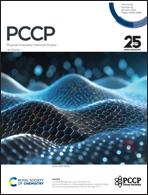Electronic structure and thermodynamic approaches to the prospect of super abundant vacancies in δ-Pu
Abstract
Super abundant vacancies (SAVs) have been suggested to form in the fcc phase of plutonium, δ-Pu, under a low-pressure hydrogen environment. Under these conditions, the vacancy concentration is proposed to reach 10−3 at% due to H trapping in vacancies lowering the effective vacancy formation energy. Previous density functional theory (DFT) results suggest that seven H atoms can be trapped in a single vacancy when a collinear special quasirandom magnetic structure is used to stabilize the δ phase, suggesting SAVs are a possible source of H stored in plutonium. In this report, we present DFT results for δ-Pu in the noncollinear 3Q magnetic state to study the formation of SAVs in mechanically stable δ-Pu. Together with these new simulations, we use publicly available computational and experimental data to provide further constraints on the physical conditions needed to thermodynamically stabilize SAVs in δ-Pu. Using several thermodynamic models, we estimate the vacancy concentrations in δ-Pu and discuss the limits of hydrogen driven formation of vacancies in δ-Pu. We find that, when hydrogen in the lattice is equilibrated with gaseous H2, the formation of SAVs in δ-Pu is unlikely and any excess vacancy concentration beyond thermal vacancies would need to occur by a different mechanism.



 Please wait while we load your content...
Please wait while we load your content...